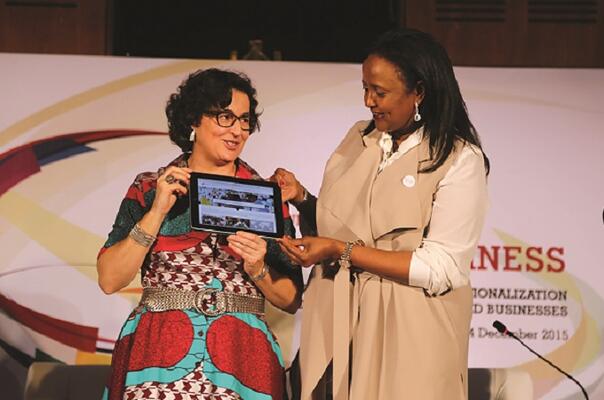
SheTrades, because she can
Stephen Elop, the former Microsoft executive, said on the takeover of Finnish mobile-device maker Nokia a couple of years ago that ‘we didn’t do anything wrong, but somehow, we lost’.
The way consumers behave, companies do business and economies trade is changing at a rapid pace. The lesson from the demise of a pioneering company such as Nokia is that adapting to these trends is inevitable, even for a development community traditionally known for its conventionality.
The International Trade Centre’s (ITC) Women and Trade programme has since it was launched placed innovation at the centre of its work. This was decision done in anticipation of an ambitious new development agenda that would underscore the importance of the achievement of gender equality and the empowerment of women.
MAXIMIZING IMPACTWe envisaged that to make a meaningful contribution to the new development agenda, we would have to deliver a programme that supports systemic change and results in longer-term impact and value. In concrete terms, this means leveraging relatively modest resources to integrate women entrepreneurs in to the economy at a significant scale.
Close to one hundred years since the first observation of International Women’s Day, despite the substantial gains in advancing women’s rights, the facts about women’s participation in the economy are sobering. ITC’s work is premised on the evidence that trade can be a powerful lever for economic resilience and transformation when women have the opportunity to fully participate. In a survey of firms across 20 countries we found that only one in five exporting companies is owned by a woman. Further analysis by the University College Dublin Centre for Economic Research of data on 19,000 firms across 99 developing countries found that women face significant discrimination barriers when exporting, including higher costs and lower benefits.
SHETRADESIt is in this context that ITC last year launched the SheTrades initiative to connect one million women to market by 2020. Following year-long consultations with a diverse range of stakeholders – including government, the private sector, development community, academia and others with mutually reinforcing interests – a set of eight key issues to be addressed was established to unlock trade opportunities for women.
Those issues are: to collect, analyse and disseminate data on women’s economic participation; to create trade policies and agreements that enhance women’s participation in trade; to empower women-owned businesses to participate in the US$10 trillion annual public procurement market (their current share is an estimated at between 1% and 5%); to create corporate procurement programmes that embed diversity and inclusion in value chains; to set up mechanisms to certify ownership and eligibility of women-owned businesses; to address supply side constraints that especially affect womenowned businesses; to close the gap between men and women for access to financial services; and to ensure legislative and administrative reforms guarantee women’s rights to ownership and control over resources.
Still, connecting women entrepreneurs to international markets is a complex matter. The SheTrades initiative provides stakeholders with a platform through which they can combine expertise, resources and networks to address the multitude of issues. It creates an ecosystem that cultivates growth and competitiveness of women entrepreneurs. At www.shetrades.com a registration, tracking and monitoring tool has been developed to highlight commitments and keep stock of progress towards the one-million-women goal. Currently in beta mode, the tool will be fully functional from April 2016.
With the right policies established, women entrepreneurs trained and mentored to be more competitive, and access to financial services made available to finance their business growth: what is left to be done is to connect them to international markets.
The most frequently cited barrier to doing business with women-owned companies is the inability to identify eligible businesses to include in the supply chain. We teamed up with Google and CI&T, a Brazilian tech company, to run a tech challenge calling on developers around the world to help us create a solution. Some 300 developers, five finalists and one winner emerged. A woman-owned company from Kenya created the SheTrades web and mobile application, which was launched in conjunction with the World Trade Organization Ministerial Conference in December 2015.
CONNECTING TO MARKETSThe SheTrades app provides women entrepreneurs around the world with a unique platform to connect to markets. At SheTrades, women entrepreneurs are able to share information about their companies, increase visibility, expand networks, connect and internationalize. SheTrades also helps corporations to include more women entrepreneurs in their supply chains. Here is what SheTrades offers women entrepreneurs:
- SheTrades lets the market know what their companies have to offer;
- It enables them to find new business and partnership opportunities;
- It matches them with companies that have complimentary interests, and;
- Provides the latest technology nut simple to use. Quick information at their fingertips all the time
SheTrades offers a place to create new business in real time, in a user-driven, dynamic and user-friendly space. The app is based on internationally recognized business protocols. SheTrades also helps companies to include more women entrepreneurs in their supply chains and successfully fulfil diversity and inclusion commitments.
Through a series of customized filters, companies can identify women entrepreneurs that could meet their sourcing requirements. As a SheTrades member, companies have full access to women entrepreneurs’ profiles and company information.
As we set out on the journey to 2030, ITC welcomes one and all to join and advance SheTrades initiative with passion, dedication and energy to drive forward the transformational change that will result in resilient, prosperous economies and just equitable societies for all humanity.
Where there is a will, there is a way.



